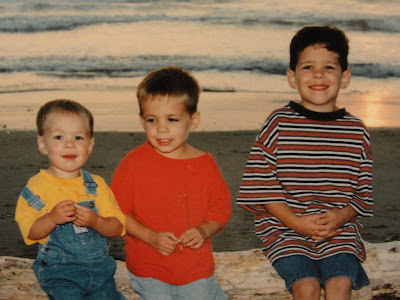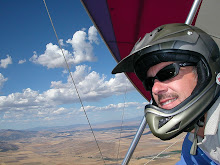I had the opportunity, along with 5 other adult leaders and 13 Scouts ages 14-17 to go on a whitewater High Adventure on an 8 mile section of the Snake River just West of Alpine, Wyoming.
We traveled on Thursday in 4 vehicles about three hours, including a stop or two along the way.
We entered the Snake River Canyon West of Alpine, WY, and then located a campsite at Wolf Creek Campground. After setting up camp and a quick lunch, we all pitched in to inflate the rafts and get ready to run the river. Teamwork was the Key!
After a river safety talk, we loaded up and drove to the boat launch at West Table Creek. The nice river-Ranger-lady informed us that groups over 15 people must have a permit, to reduce the impact on the river and ease bottlenecks at put-ins and take-outs. Because it was a not too busy Thursday, she agreed to allow us to run together today only, but said we must divide into two separate groups with an hour between launches on Friday and Saturday.
So we didn't argue, but quickly unloaded our rafts, people and gear, and prepared to launch while four of us shuttled vehicles to the Sheep Gulch boat ramp takeout.
Then we launched between the other big commercial trips and were on our way! The weather was perfect - sunny and warm in the 80's. Just the right temperature to warm you up after a dip in the icy waters or getting soaked in the rapids.
We had three nice self-bailing 6-7 person paddle boats - just the right size for a wild ride through the rapids, without sacrificing too much stability. The river was running between 11,000 and 12,000 cfs during the 3 days we were there, which is moderately "high water." This results in some rapids, such as Big Kahuna, being washed out and wimpy; But other rapids,
such as the famous Lunch Counter, were amplified!
The entire 8 mile daily run includes mostly Class II and III rapids, although some can become Class IV depending on water levels.
There are sections of "flat water" between numerous rapids with names such as "Three Oar Deal", "Taco Hole", "Big Kahuna", "Lunch Counter" and others.
The scenery is beautiful with the surrounding pine forests and high mountains in the distance. We also saw deer, bald eagles, hawks, squirrels, rockchucks, camp robbers and other wildlife.
Anxiety was high on the first run, as the younger Scouts had already been filled with tales of the last trip to this same canyon three years ago. The river and rapids did not disappoint, as a great ride was had by all.
Nearly everyone got in the river at some point - some by choice...
...others "involuntarily." *(Yes - both of these adult leaders fell in here!)
Because of the fast flowing river, the entire trip took about an hour and a half.
We returned to camp, and then made the half hour drive to Jackson, WY for dinner at Bubbas!
After dinner we explored the town square.
The main purpose of this trip was to allow everyone to have some good, safe, mostly sane, high adventure FUN, while practicing Scouting skills and principles, and helping everyone learn some valuable life lessons - which we definitely accomplished.
As leaders we also planned some spiritual river-guide based "life lessons" - focusing on different types of guides each young man can use to help navigate the challenges of life. These included: teacher/leader guides, our self as a guide, peer guides, parental guides, and spiritual guides. It was the perfect setting and opportunity to teach some important lessons that will hopefully make a difference sooner or later in their lives.
The next day, after a good breakfast, we made a plan for the day. We considered how we might somehow be able to bend the river rules and stay together as a group even though we did not have a permit. We decided instead that we should set an example of integrity and obedience for the young men, so we divided into a group of 13 in two rafts and a group of six in the remaining raft.
One group launched at the Elbow boat ramp while the vehicles were shuttled down to the take-out. Then the second group launched at East Table Creek boat ramp, allowing for plenty of time between our two groups so that we would be in compliance with the river regulations.
It turned out to be a good thing that we did abide by the rules, as the river Rangers were stationed at the take-out ramp! Staying together without a permit would have resulted in an expensive ticket, and being sent home early. It all worked out just fine, as we got better at the logistics of the shuttles with each run, and the Scouts rotated between boats and leaders with each trip. I know the "boys" learn much more by example, versus just what they are told. With six adult leaders, we had two leaders per raft, which was a nice ratio - especially when one - or two leaders on a boat got thrown in the river at Lunch Counter! Part of what we also wanted to accomplish was each Scout having an opportunity to practice river rescue skills - which they had plenty of opportunity!
We had our third run of the river on Friday afternoon, and encountered more wet & wild rapids...
...and even some rogue (and inebriated) Pirates!
We made it safely through the second day, and had a yummy dinner of dutch oven potatoes and chicken.The USFS campgrounds make it very clear that we are in "bear country" in this canyon. Each campsite has it's own solid steel "bear box" - where all food and toiletries must be secured when they are not being used. Any trash, food or debris left out could result in an expensive ticket from the Ranger - and a scary, dangerous visit from a bear! Of course, four curious Scouts found other creative uses for the bear boxes!
We had an early campfire and reviewed lessons learned on the river that day, as each participant had been encouraged to look for analogies between our experiences on the river and our life. Many of the comparisons were very insightful and well thought out. After a long hard day of play on the river, most people went to bed earlier than the first night.
We arose by 7 am on Saturday, had breakfast, broke camp, and prepared for our last run on the river. It was a cooler morning, but about halfway through the run the sun peeked out and warmed us up. It was another fun run to cap off an awesome adventure.
The surfers were out in force at Lunch Counter, surfing the standing waves between each raft that came through.
We then stopped for some cliff-jumping,
or back-flipping!
After taking out for the final time at Sheep Gulch, we returned to camp to put away rafts and gear, have a quick lunch, and depart for home.
On the way home most passengers slept - although some stayed awake and found new ways to entertain themselves (and others) with duct tape,
fishing line and a tennis ball!
We all made it safely home to hot showers and warm beds, where we drifted off to sleep to the rocking of the river waves.










